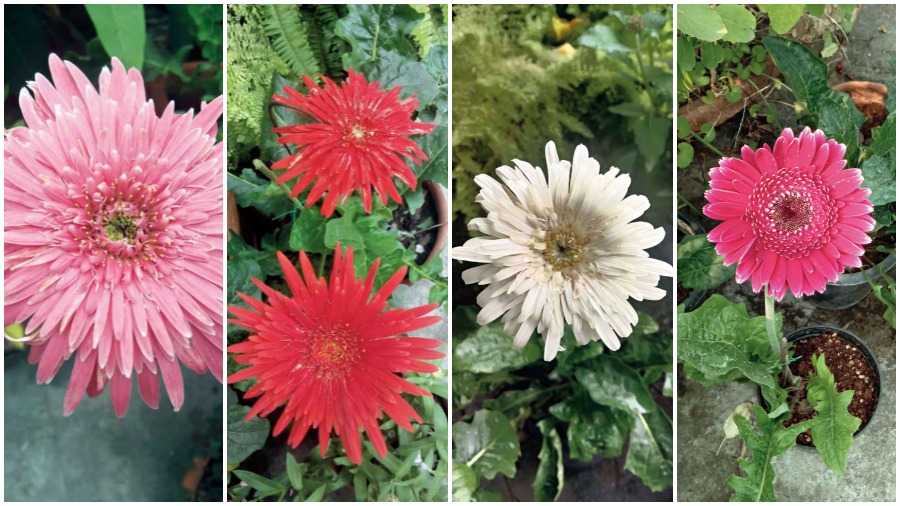No visit to the flower shop is complete without — if not buying then at least — admiring the beautiful gerberas on display.
Due to its high vase life this plant has become very popular as a cut flower, and is extensively cultivated nowadays. Native to Asia, Africa and South America, this highly decorative flower-producing plant happens to be the fifth most popular cut flower across the world today.
The gerbera belongs to the Asteraceae or daisy/ sunflower family. It is a tender perennial plant, also known as African Daisy, Transvaal daisy or Barberton daisy. The gerbera flowers profusely from November to March and like sunflowers, they follow the direction of the sun from east to west. It is a perfect plant for pot culture. It thrives best in full sun and soil that is moist and well-drained.
Let us see how you can grow it best in your garden.
Temperature – Gerbera can tolerate a maximum heat of about 24 or 25° C and night temperature of about 14 to 18° C. It needs at least four to five hours of morning sunlight and indirect sunlight or bright light for the rest of the day. In summer months, it needs to be kept in indirect sunlight. Gerbera plants grown in locations with insufficient light will not bloom well.
Potting mix – For good root growth and good penetration of roots, the soil should be highly porous and well drained.
Use 50 per cent sandy soil, 30 per cent vermicompost or well-rotted cow manure and 20 per cent coco peat. To this mix, add one cup neem cake dust, one cup bone dust, ¼cup super phosphate, one teaspoon magnesium sulphate and one teaspoon fungicide.
Alternatively, you may use 40 per cent coco peat, 40 per cent pumice or perlite and 20 per cent vermicompost or well-rotted cow manure or leaf mould. To this mix add one cup neem cake dust, one cup bone dust, ¼cup super phosphate, one tea spoon magnesium sulphate and one teaspoon fungicides.
Watering – The Gerbera loves moisture but over-watering kills the plant. So water when the media is on the drier side. It is best to check the media by inserting a stick or finger in the pot before watering. If it is one inch or so dry from the top, water thoroughly. Gerbera plants should be protected from continuous rain.
Fertiliser – Use balanced (20:20:20 or 19:19:19) NPK 1tsp every week with ½tsp di-ammonium phosphate (DAP) and ½tsp epsom salt (magnesium sulphate) per pot from November to March.
Spray water-soluble micronutrients (1g/l) on foliage once fortnightly. In summer months apply the same fertilisers but in a monthly interval.
Propagation – Gerberas can be propagated by germination of seeds, tissue culture or offshoots division. Tissue culture is a complex process. It requires a special set up or laboratory to propagate plants.
Propagation by seeds is time-consuming and the success rate is comparatively low. Most of the seeds from cut flowers are immature and so are unable to germinate properly.
Seed-grown plants will take very long to mature and produce flowers. Plants from seeds will bloom in the second year and produce good quality flowers from the third year onwards.
Offshoots division is a very popular method to multiply Gerbera plants. A Gerbera clump is divided in two or three parts and the offshoots are planted in freely-draining and aerated soil.
Do not insert the crown of the plant in the soil or it will rot. Keep them in a shaded place for a week and slowly introduce them to the sun. They will thrive easily within a few weeks.
Disease/ pest control- Gerbera is very prone to fungus and root rot. It may require systemic fungicide and pesticide.
Use Saaf/ Bavistin fungicide (2g/L) and Plantomicine (1g /l) as foliar spray in the afternoon for fungal diseases fortnightly.
In the next cycle, spray Tafgor/ Rogor (2ml /L) or any other pesticide in the afternoon.
Care tips- for better health and more flower production, remove the dead heads and old dry leaves.
Weeds should be removed from the pot and raking of soil needs to be done fortnightly to increases soil aeration in the root zone of gerbera plants.
